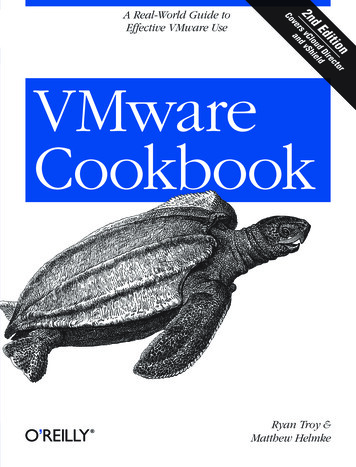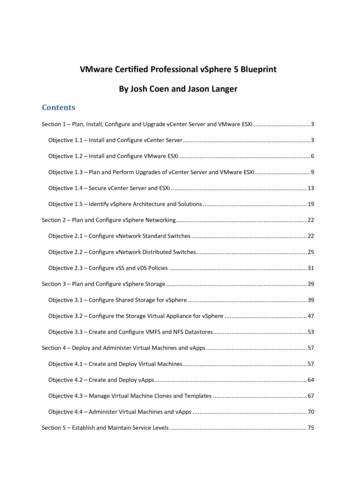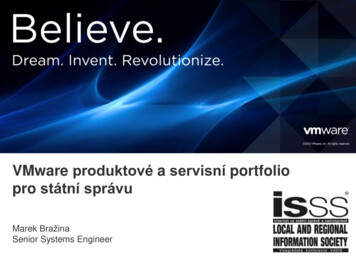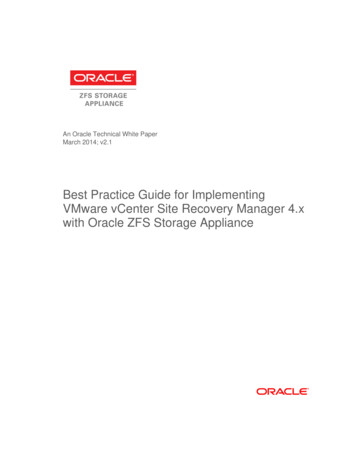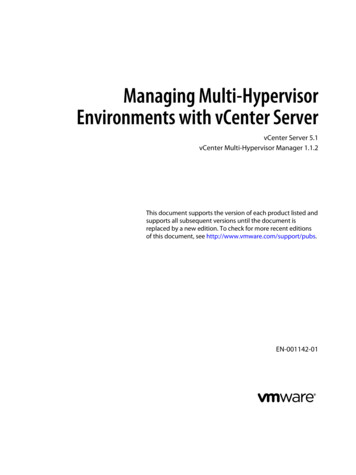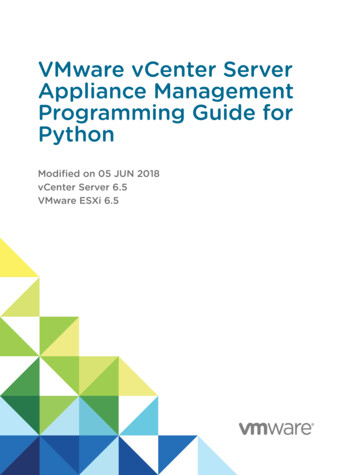
Transcription
VMware vCenter ServerAppliance ManagementProgramming Guide forPythonModified on 05 JUN 2018vCenter Server 6.5VMware ESXi 6.5
VMware vCenter Server Appliance Management Programming Guide for PythonYou can find the most up-to-date technical documentation on the VMware website at:https://docs.vmware.com/If you have comments about this documentation, submit your feedback todocfeedback@vmware.comVMware, Inc.3401 Hillview Ave.Palo Alto, CA 94304www.vmware.comCopyright 2016–2018 VMware, Inc. All rights reserved. Copyright and trademark information.VMware, Inc.2
ContentsAbout the vCenter Server Appliance Management Programming Guide for PythonUpdated Information561 Introduction to the vCenter Server Appliance and vCenter Server ApplianceAPIs7About vSphereAbout ESXi77vCenter Server Appliance Management Overview8Limitations of Programming for the vCenter Server ApplianceAPI Endpoints for Managing the vCenter Server ApplianceSupplementing the vCenter Server Appliance APIQuick Start with vCenter Server Appliance APIs899102 vCenter Server Appliance Programming Environment 11Platform Services Controller Services11Platform Services in the vCenter Server Appliance EnvironmentvSphere Deployment Configurations13133 Retrieving Service Endpoints 16Filtering for Predefined Service Endpoints17Filter Parameters for Predefined Service Endpoints18Connect to the Lookup Service and Retrieve the Service Registration Object19Python Example of Connecting to the Lookup Service and Retrieving a Service Registration ObjectRetrieve Service Endpoints on vCenter Server Instances20Python Example of Retrieving Service Endpoints on vCenter Server InstancesRetrieve a vCenter Server ID by Using the Lookup Service192121Python Example of Retrieving a vCenter Server ID by Using the Lookup ServiceRetrieve a vSphere Automation Endpoint on a vCenter Server Instance2222Python Example of Retrieving a vSphere Automation Endpoint on a vCenter Server Instance234 Authentication Mechanisms 24vCenter Single Sign-On User Name and Password Authentication for thevCenter Server Appliance24vCenter Single Sign-On Token Authentication for the vCenter Server Appliance265 Authorization Model for Administration of the vCenter Server Appliance 31Authorization Model Mapping to the vCenter Single Sign-On DomainVMware, Inc.313
VMware vCenter Server Appliance Management Programming Guide for PythonUsing the Appliance Operator RoleUsing the Appliance Admin Role3232Using the Appliance SuperAdmin Role326 Overview of vCenter Server Appliance Interfaces 33appliance access Interfaceappliance health Interface3334appliance monitoring Interface34appliance networking Interface35appliance networking dns Interfaceappliance recovery Interface3535appliance system version Interfaceappliance system time Interface3535appliance system uptime Interfaceappliance system storage Interface36367 Monitoring the vCenter Server Appliance 37Health Monitoring of the vCenter Server ApplianceCapacity Monitoring of the vCenter Server Appliance37388 Maintenance of the vCenter Server Appliance 45Backing up the vCenter Server ApplianceRestoring the vCenter Server ApplianceVMware, Inc.45494
About the vCenter Server ApplianceManagement Programming Guide forPythonThe vCenter Server Appliance Management Programming Guide for Python provides information aboutusing APIs to work with the vCenter Server Appliance, a turnkey solution for managing data centers featuring VMware vCenter Server and VMware ESXi.Intended AudienceThis information is intended for anyone who wants to develop software to configure, monitor, and managethe vCenter Server Appliance. The information is written for developers who have some experience withPython.VMware Technical Publications GlossaryVMware Technical Publications provides a glossary of terms that might be unfamiliar to you. Fordefinitions of terms as they are used in VMware technical documentation, go tohttp://www.vmware.com/support/pubs.VMware, Inc.5
Updated InformationThis VMware vCenter Server Appliance Management Programming Guide for Python is updated witheach release of the product or when necessary.This table provides the update history of the VMware vCenter Server Appliance ManagementProgramming Guide for Python.RevisionDescription05 JUN 2018Updated some code snippets.30 NOV 2017Refined multiple topics.15 NOV 2016Initial release.VMware, Inc.6
Introduction to thevCenter Server Appliance andvCenter Server Appliance APIs1The vCenter Server Appliance provides a fully packaged solution for data center management in avSphere environment. You can use the APIs to configure, monitor, and maintain thevCenter Server Appliance.This chapter includes the following topics:nAbout vSpherenAbout ESXinvCenter Server Appliance Management OverviewnLimitations of Programming for the vCenter Server AppliancenAPI Endpoints for Managing the vCenter Server AppliancenSupplementing the vCenter Server Appliance APInQuick Start with vCenter Server Appliance APIsAbout vSpherevSphere is the VMware software stack that implements private-cloud data center management and theon-premises component of hybrid-cloud deployments.A vSphere installation includes one or more instances of vCenter Server configured to manage one ormore virtual data centers. Each virtual data center includes one or more instances of VMware ESXi.The vCenter Server Appliance contains an instance of vCenter Server. The appliance Management APIgives you programmatic access to manage the management elements of your data center.About ESXiEach instance of ESXi includes management agents and the VMware hypervisor layer, which runsseveral virtual machines. Each virtual machine contains a guest operating system, such as Windows orLinux, capable of running IT or user applications.The vCenter Server Appliance runs as a virtual machine on an ESXi host. The appliance provides anindependent endpoint capable of handling API requests both for vCenter Server and for the applianceManagement API.VMware, Inc.7
VMware vCenter Server Appliance Management Programming Guide for PythonvCenter Server Appliance Management OverviewThe vCenter Server Appliance is an instance of vCenter Server running in a Photon OS guest operatingsystem.vCenter Server is a collection of services designed for managing and monitoring vSphere installations.The vCenter Server Appliance responds to CLI commands, requests from the vSphere Web Client, andAPI requests from custom clients. API clients can be written in a choice of several software languages.The vCenter Server Appliance is managed by CLI, Web interfaces, or API requests. These requests helpyou manage appliance configuration, monitor resource usage, or back up and restore the vCenter Serverinstance. You can also use API requests to check the health of the vCenter Server installed in theappliance. This programming guide explains how to use the APIs that are available to manage theappliance.Figure 1‑1. vCenter Server Appliance Management ConnectionsShell APIs(SSH TTY1)vSphereWebClientAPI/DCLIClientHTTPS RESTvCenter ServerApplianceManagement InterfaceHTTPS RESTvAPI Endpoint(443)DCUI(Linux Binary UIon TTY2 console)HTTPS RESTWeb Server(5480)vAPI providerManagement ServiceConfiguration ServiceFor more information about the capabilities of the vCenter Server Appliance, seevCenter Server Appliance Configuration.Limitations of Programming for thevCenter Server ApplianceThe vCenter Server Appliance supports several programming interfaces for monitoring appliance healthand performance, managing network configuration, security hardening, and other functionalities. ThevCenter Server Appliance also supports several user interfaces, which offer overlapping sets offunctionality.You can use vSphere Web Client to perform common operations. By using the API, you have access tomore specific settings and operations.VMware, Inc.8
VMware vCenter Server Appliance Management Programming Guide for PythonHowever, the API cannot access all the capabilities. A few special features require direct shell access orspecial user interfaces. See Supplementing the vCenter Server Appliance API.API Endpoints for Managing the vCenter Server ApplianceThe vCenter Server Appliance integrates with the vSphere Automation API endpoint that provides acommon surface for exposing several vSphere services. When you use the vSphere Automation APIendpoint, you establish a single session that provides access to virtual machine management, search andfilter, Content Library, and other services for working with vSphere objects.Other endpoints associated with the vCenter Server Appliance include the Lookup Service and thevCenter Single Sign-On Service. For more information about using the Lookup Service, see Chapter 3Retrieving Service Endpoints. For more information about using the vCenter Single Sign-On Service, seevCenter Single Sign-On Token Authentication for the vCenter Server Appliance.Supplementing the vCenter Server Appliance APISome less common features of the vCenter Server Appliance are not accessible by API. These featuresrequire direct shell access or specific user interfaces.Direct Console User Interface to the vCenter Server ApplianceThe Direct Console User Interface provides access to basic operations for appliance management andset up.The DCUI provides access to a subset of management functions. It provides direct access to theappliance if the vSphere Web Client and the vCenter Server Appliance Management Interface becomeunavailable.For an illustration showing appliance connections, see the block diagram Figure 1‑1.After the vCenter Server Appliance startup is complete, the DCUI displays basic CPU, memory, andnetwork information on the operator console. The root user can use the DCUI screen to configure networkinterfaces, DNS, and super administrator password.vCenter Server Appliance Management InterfaceThe vCenter Server Appliance Management Interface is an interface for configuring, monitoring, andpatching of the vCenter Server Appliance.The vCenter Server Appliance Management Interface runs in a browser that connects to port 5480 of theappliance. The vCenter Server Appliance Management Interface provides access to all the service APIsof the appliance.For an illustration showing Appliance connections, see the block diagram Figure 1‑1.VMware, Inc.9
VMware vCenter Server Appliance Management Programming Guide for PythonAppliance Shell and the vCenter Server ApplianceYou can use the appliance shell to access all of the vCenter Server Appliance commands and plug-insthat you use for monitoring, troubleshooting, and configuring the appliance through the API.For an illustration showing Appliance connections, see the block diagram Figure 1‑1.For more information about the appliance shell, see vCenter Server Appliance Configuration.vSphere Web Client and the vCenter Server ApplianceThe vSphere Web Client is a user interface for general management tasks.For an illustration showing Appliance connections, see the block diagram Figure 1‑1.DCLI and the vCenter Server Appliance The Data Center CLI (DCLI) is a CLI client of the VMware vSphere Automation SDK. Almost allmethods that are available in the vSphere Automation SDKs are available as DCLI commands. You can run the DCLI from the VMware vSphere Command-Line Interface (vCLI) package or from theappliance shell.For an illustration showing appliance connections, see the block diagram Figure 1‑1.For more information about the DCLI, see Getting Started with vSphere Command-Line Interfaces.Quick Start with vCenter Server Appliance APIsYou can start using the vCenter Server Appliance APIs without accessing the Lookup Service Endpoint orthe vCenter Single Sign-On Endpoint. In a production environment, you might instead use centralizedservice registration and token authentication.To use the vCenter Server Appliance APIs without the Lookup Service or token authentication, seevCenter Single Sign-On User Name and Password Authentication for the vCenter Server Appliance.VMware, Inc.10
vCenter Server ApplianceProgramming Environment2The vCenter Server Appliance is a key component in your vSphere environment, providing severalservices for data center management, as well as its own management.This chapter includes the following topics:nPlatform Services Controller ServicesnPlatform Services in the vCenter Server Appliance EnvironmentnvSphere Deployment ConfigurationsPlatform Services Controller ServicesWith Platform Services Controller, all VMware products within the same environment can share theauthentication domain and other services. Services include certificate management, authentication, andlicensing.Platform Services Controller includes the following core infrastructure services.Table 2‑1. Platform Services Controller ServicesServiceDescriptionapplmgmtHandles appliance configuration and provides public APIendpoints for appliance lifecycle management. Included on thePlatform Services Controller appliance.(VMware Appliance Management Service)vmware-cis-license(VMware License Service)Each Platform Services Controller includes VMware LicenseService, which delivers centralized license management andreporting functionality to VMware products in yourenvironment.The license service inventory replicates across allPlatform Services Controller in the domain at 30-secondintervals.vmware-cm(VMware Component Manager)Component manager provides service registration and lookupfunctionalities.vmware-psc-clientBackend to the Platform Services Controller Web interface.(VMware Platform Services Controller Client)VMware, Inc.11
VMware vCenter Server Appliance Management Programming Guide for PythonTable 2‑1. Platform Services Controller Services es behind the vCenter Single Sign-On feature, whichprovide secure authentication services to VMware softwarecomponents and users.(VMware Identity Management Service)vmware-stsd(VMware Security Token Service)By using vCenter Single Sign-On, the VMware componentscommunicate using a secure SAML token exchangemechanism. vCenter Single Sign-On constructs an internalsecurity domain (vsphere.local by default) where the VMwaresoftware components are registered during installation orupgrade.vmware-rhttpproxyThe reverse proxy runs on each Platform Services Controllernode and each vCenter Server system. It is a single entry pointinto the node and enables services that run on the node tocommunicate securely.(VMware HTTP Reverse Proxy)vmware-scaManages service configurations. You can use the service-(VMware Service Control Agent)control CLI to manage individual service configurations.vmware-statsmonitorMonitor the vCenter Server Appliance guest operating systemresource consumption.(VMware Appliance Monitoring Service)vmware-vapi-endpoint(VMware vAPI Endpoint)vmafddVMware Authentication FrameworkvmcadVMware Certificate ServiceThe vSphere Automation API endpoint provides a single pointof access to vAPI services. You can change the properties ofthe vAPI Endpoint service from the vSphere Web Client. Seethe vSphere Automation SDKs Programming Guide for detailson vAPI endpoints.Service that provides a client-side framework for vmdirauthentication and serves the VMware Endpoint CertificateStore (VECS).Provisions each VMware software component that has thevmafd client libraries and each ESXi host with a signedcertificate that has VMCA as the root certificate authority. Youcan change the default certificates by using the CertificateManager utility or Platform Services Controller Web interface.VMware Certificate Service uses the VMware EndpointCertificate Store (VECS) to serve as a local repository forcertificates on every Platform Services Controller instance.Although you can decide not to use VMCA and instead canuse custom certificates, you must add the certificates to VECS.vmdirdVMware Directory ServiceProvides a multitenant, multimastered LDAP directory servicethat stores authentication, certificate, lookup, and licenseinformation. Do not update data in vmdird by using an LDAPbrowser.If your domain contains more than onePlatform Services Controller instance, an update of vmdircontent in one vmdir instance is propagated to all otherinstances of vmdir.vmdnsdNot used in vSphere 6.x.VMware Domain Name ServiceVMware, Inc.12
VMware vCenter Server Appliance Management Programming Guide for PythonTable 2‑1. Platform Services Controller Services (Continued)ServiceDescriptionvmonapiStart and stop vCenter Server services and monitor serviceAPI health. The vmware-vmon service is a centralized platform-VMware Lifecycle Manager APIvmware-vmonVMware Service Lifecycle ManagerlwsmdLikewise Service Managerindependent service that manages the lifecycle ofPlatform Services Controller and vCenter Server. ExposesAPIs and CLIs to third-party applications.Likewise facilitates joining the host to an Active Directorydomain and subsequent user authentication.Platform Services in the vCenter Server ApplianceEnvironmentThe vCenter Server Appliance registers its services with the Platform Services Controller, but in somesituations you might be unable to use the Lookup Service registration. In those situations, you mustaccess an appliance endpoint directly.A direct connection to the vCenter Server Appliance can become necessary in configurations where thePlatform Services Controller is embedded in the appliance. When the appliance vCenter Server is beingrestored from a backup, or when the embedded Lookup Service is restarting, you might be unable to lookup the appliance's service registration.For more information about embedded or external Platform Services Controller configurations, seevSphere Deployment Configurations.For more information about backup and restore operations, see Chapter 8 Maintenance of the vCenterServer Appliance.vSphere Deployment ConfigurationsvSphere Automation client applications communicate with services on the Platform Services Controllerand vCenter Server components of the virtual environment. vCenter Server can be deployed with anembedded or external Platform Services Controller.vCenter Server with an Embedded Platform Services ControllervCenter Server and Platform Services Controller reside on the same virtual machine or physical server.This deployment is most suitable for small environments such as development or test beds.You can use the Platform Services Controller in two ways to establish secure, authenticated sessions foryour client application, by making requests to the Lookup Service and the vCenter Single Sign-OnService.VMware, Inc.13
VMware vCenter Server Appliance Management Programming Guide for PythonOne way to use the Platform Services Controller is to request an authentication token that can be used toauthenticate requests across services. The client connects to the Lookup Service and retrieves thevCenter Single Sign-On Service endpoint and the vSphere Automation API endpoint. The client then usesthe vCenter Single Sign-On endpoint to authenticate with user credentials and receive a token thatsecurely verifies the client's credentials. This allows the client to authenticate with a number of serviceendpoints without sending user credentials over the network repeatedly.Alternatively, if the client connects directly to the vSphere Automation API endpoint, there is no need forthe client to interact with the vCenter Single Sign-On Service. The client sends user credentials to thevSphere Automation API endpoint, which creates a session identifier that persists across requests.Figure 2‑1. vCenter Server with Embedded Platform Services ControllerVM or Physical ServerPlatform Services ControllerLookupServiceSingle Sign-OnService URLvSphere AutomationEndpoint URLvCenter ServerURLOther ServicesURLsSingleSign-ONServiceSAML TokenVMware ESXivCenter ServervAPIEndpointContent LibraryServiceТaggingServiceOther ServicesVMVMware ESXivCenter Server with an External Platform Services ControllerIn the case of an external Platform Services Controller, the vCenter Server and thePlatform Services Controller are deployed on separate virtual machines or physical servers. ThePlatform Services Controller can be shared across several vCenter Server instances. For largerdeployments or to provide better availability, more than one Platform Services Controller can be deployed.When configured as replication partners within a single vCenter Single Sign-On domain,Platform Services Controller instances replicate all user and system data within the cluster.A client application functions in a similar way as in a Platform Services Controller with embeddedvCenter Server deployment. The only difference is that the client application can access services onmultiple vCenter Server instances, or services only on a particular vCenter Server instance.VMware, Inc.14
VMware vCenter Server Appliance Management Programming Guide for PythonFigure 2‑2. vCenter Server with External Platform Services ControllerVM or Physical ServerPlatform Services ControllerLookupServiceSingle Sign-OnService URLvSphere AutomationEndpoint URLvCenter ServerURLOther ServicesURLsSingleSign-ONServiceSAML TokenVM or Physical ServerVM or Physical ServervCenter ServervAPIEndpointVMware ESXiVMware, Inc.vCenter ServerContent LibraryServiceТaggingServiceOther ServicesVMware ESXivAPIEndpointVMware ESXiContent LibraryServiceТaggingServiceOther ServicesVMware ESXi15
Retrieving Service Endpoints3To access services and resources in the virtual environment, vSphere Automation API client applicationsmust know the endpoints of vSphere Automation and vSphere services. Client applications retrieveservice endpoints from the Lookup Service that runs on the Platform Services Controller.The Lookup Service provides service registration and discovery by using a Web services API. By usingthe Lookup Service, you can retrieve endpoints of services on the Platform Services Controller andvCenter Server. The following endpoints are available from the Lookup Service.nThe vCenter Single Sign-On endpoint on the Platform Services Controller. You use the vCenterSingle Sign-On service to get a SAML token and establish an authenticated session with avSphere Automation endpoint or a vCenter Server endpoint.nThe vSphere Automation Endpoint on vCenter Server. Through the vSphere Automation Endpoint,you can make requests to vSphere Automation API services such as virtual machine management,Content Library, and Tagging.nThe vCenter Server endpoint. In an environment with external Platform Services Controller instances,you can use the vCenter Server endpoint to get the node ID of a particular vCenter Server instance.By using the node ID , you can retrieve service endpoints on that vCenter Server instance.nThe vSphere API endpoint and endpoints of other vSphere services that run on vCenter Server.Workflow for Retrieving Service EndpointsThe workflow that you use to retrieve service endpoints from the Lookup Service might vary depending onthe endpoints that you need and their number. Follow this general workflow for retrieving serviceendpoints.1Connect to the Lookup Service on the Platform Services Controller and service registration object sothat you can query for registered services.2Create a service registration filter for the endpoints that you want to retrieve.3Use the filter to retrieve registration information for services from the Lookup Service.4Extract one or more endpoint URLs from the array of registration information that you receive fromthe Lookup Service.VMware, Inc.16
VMware vCenter Server Appliance Management Programming Guide for PythonThis chapter includes the following topics:nFiltering for Predefined Service EndpointsnFilter Parameters for Predefined Service EndpointsnConnect to the Lookup Service and Retrieve the Service Registration ObjectnPython Example of Connecting to the Lookup Service and Retrieving a Service Registration ObjectnRetrieve Service Endpoints on vCenter Server InstancesnPython Example of Retrieving Service Endpoints on vCenter Server InstancesnRetrieve a vCenter Server ID by Using the Lookup ServicenPython Example of Retrieving a vCenter Server ID by Using the Lookup ServicenRetrieve a vSphere Automation Endpoint on a vCenter Server InstancenPython Example of Retrieving a vSphere Automation Endpoint on a vCenter Server InstanceFiltering for Predefined Service EndpointsThe Lookup Service maintains a registration list of vSphere services. You can use the Lookup Service toretrieve registration information for any service by setting a registration filter that you pass to the List()function on the Lookup Service. The functions and objects that you can use with the Lookup Service aredefined in the lookup.wsdl file that is part of the SDK.Lookup Service Registration FiltersYou can query for service endpoints through a service registration object that you obtain from the LookupService. You invoke the List() function on the Lookup Service to list the endpoints that you need bypassing LookupServiceRegistrationFilter. LookupServiceRegistrationFilter identifies theservice and the endpoint type that you can retrieve.Optionally, you can include the node ID parameter in the filter to identify the vCenter Server instancewhere the endpoint is hosted. When the node ID is omitted, the List() function returns the set ofendpoint URLs for all instances of the service that are hosted on different vCenter Server instances in theenvironment.For example, a LookupServiceRegistrationFilter for querying the vSphere Automation service hasthese service endpoint elements.Table 3‑1. Service Registration Filter ParametersFilter iceTypeproduct "com.vmware.cis"vSphere Automation namespace.type "cs.vapi"Identifies the vSphere Automationservice.VMware, Inc.17
VMware vCenter Server Appliance Management Programming Guide for PythonTable 3‑1. Service Registration Filter Parameters (Continued)Filter ointTypetype "com.vmware.vapi.endpoint"Specifies the endpoint path for theservice.protocol "vapi.json.https.public"Identifies the protocol that will beused for communication with theendpoint .For information about the filter parameter of the available predefined service endpoints, see FilterParameters for Predefined Service Endpoints.Filter Parameters for Predefined Service EndpointsDepending on the service endpoint that you want to retrieve, you provide different parameters to theLookupServiceRegistrationFilter that you pass to the List() function on the Lookup Service. Tosearch for services on a particular vCenter Server instance, set the node ID parameter to the filter.Table 3‑2. Input Data for URL Retrieval for the Lookup Service Registration FilterServiceInput DataValuevCenter Single Sign-Onproduct namespacecom.vmware.cisservice typecs.identityprotocolwsTrustendpoint typecom.vmware.cis.cs.identity.ssoproduct namespacecom.vmware.cisservice typecs.vapiprotocolvapi.json.https.publicendpoint typecom.vmware.vapi.endpointproduct namespacecom.vmware.cisservice typevcenterserverprotocolvmomiendpoint typecom.vmware.vimproduct namespacecom.vmware.vim.smsservice typesmsprotocolhttpsendpoint typecom.vmware.vim.smsproduct namespacecom.vmware.vim.smsservice typesmsprotocolhttpsendpoint typecom.vmware.vim.pbmproduct namespacecom.vmware.vim.smsvSphere Automation EndpointvCenter ServervCenter Storage MonitoringServicevCenter Storage Policy-BasedManagementvSphere ESX Agent ManagerVMware, Inc.18
VMware vCenter Server Appliance Management Programming Guide for PythonTable 3‑2. Input Data for URL Retrieval for the Lookup Service Registration Filter(Continued)ServiceInput DataValueservice typecs.eamprotocolvmomiendpoint typecom.vmware.cis.cs.eam.sdkConnect to the Lookup Service and Retrieve the ServiceRegistration ObjectYou must connect to the Lookup Service to gain access to its operations. After you connect to the LookupService, you must retrieve the service registration object to make registration queries.Procedure12Connect to the Lookup Service.aConfigure a connection stub for the Lookup Service endpoint, which uses SOAP bindings, byusing the HTTPS protocol.bCreate a connection object to communicate with the Lookup Service.Retrieve the Service Registration Object.aCreate a managed object reference to the Service Instance.bInvoke the RetrieveServiceContent() method to retrieve the ServiceContent data object.cSave the managed object reference to the service registration object.With the service registration object, you can make registration queries.Python Example of Connecting to the Lookup Service andRetrieving a Service Registration ObjectThe example is based on the code from the lookup service helper.py sample file.Note For a complete and up-to-date version of the sample code, see the vSphere Automation SDKPython samples at GitHub.# 1 - Create SOAP client object to communicate with the Lookup Service.my ls stub Client(url wsdl url, location ls url)# 2 - Configure service & port type for client transaction.my ls stub.set options(service 'LsService', port 'LsPort')# 3 - Manufacture a managed object reference.managed object ref \VMware, Inc.19
VMware vCenter Server Appliance Management Programming Guide for Pythonmy ls anaged object ref. type 'LookupServiceInstance'managed object ref.value 'ServiceInstance'# 4 - Retrieve the ServiceContent object.ls service content \my ls stub.service.RetrieveServiceContent(managed object ref)# 5 - Retrieve the service registration object.service registration ls service content.serviceRegistrationRetrieve Service Endpoints on vCenter Server InstancesYou can create a function that obtains the endpoint URLs of a service on all vCenter Server instances inthe environment. You can modify that function to obtain the endpoint URL of a service on a particularvCenter Server instance.PrerequisitesnEstablish a connection with the Lookup Serv
The vCenter Server Appliance Management Interface is an interface for configuring, monitoring, and patching of the vCenter Server Appliance . The vCenter Server Appliance Management Interface runs in a browser that connects to port 5480 of the appliance. The vCenter Server Appliance Management Interface provides access to all the service APIs
